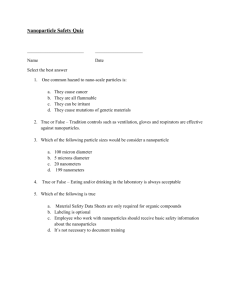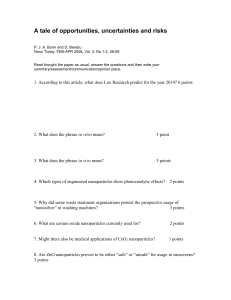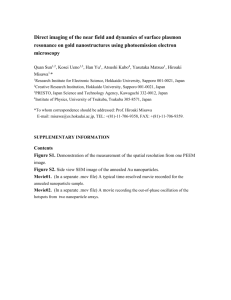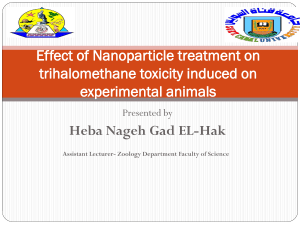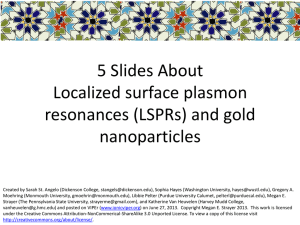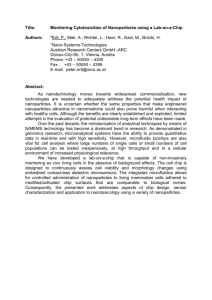Aerosol formation and lab studies - National Center for Atmospheric
advertisement
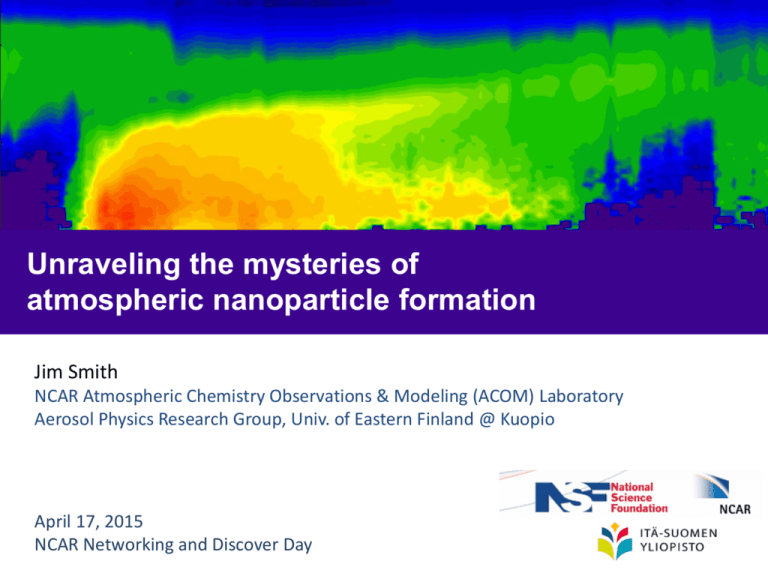
Unraveling the mysteries of atmospheric nanoparticle formation Jim Smith NCAR Atmospheric Chemistry Observations & Modeling (ACOM) Laboratory Aerosol Physics Research Group, Univ. of Eastern Finland @ Kuopio April 17, 2015 NCAR Networking and Discover Day Acknowledgements: The New Particle Formation Team Markku Kulmala U Helsinki Ari Laaksonen Finn Met Inst Annele Kelley Murray Virtanen Barsanti Johnston U E. Finland UC Riverside U Delaware Lea Paul Winkler Jun Zhao Hildebrandt Ruiz Chris Hogan U Minn John Ortega Funding Agencies: • National Science Foundation • Department of Energy • Finnish Academy & Saastamoinen Foundation Fred Eisele NCAR Mike Lawler Pete McMurry U Minn Why should we care about atmospheric nanoparticles? • Nanoparticles are the “building blocks” of atmospheric aerosols … their formation is observed around the world and their growth to larger sizes is important for cloud formation. • Nanoparticles may have health impacts because of their ability to translocate. • Nanoparticles are a unique state of matter that lie in the transition between molecular clusters (~1 nm) and bulk aerosol (>50 nm). diameter that can activate into a cloud droplet at 0.2% supersaturation Why should we care about atmospheric nanoparticles? • Nanoparticles are the “building blocks” of atmospheric aerosols … their formation is observed around the world and their growth to larger sizes is important for cloud formation. • Nanoparticles may have health impacts because of their ability to translocate. • Nanoparticles are a unique state of matter that lie in the transition between molecular clusters (~1 nm) and bulk aerosol (>50 nm). Oberdörster, 2005 Why should we care about atmospheric nanoparticles? • Nanoparticles are the “building blocks” of atmospheric aerosols … their formation is observed around the world and their growth to larger sizes is important for cloud formation. • Nanoparticles may have health impacts because of their ability to translocate. • Nanoparticles are a unique state of matter that lie in the transition between molecular clusters (~1 nm) and bulk aerosol (>50 nm). Measuring the chemical composition of atmospheric nanoparticles The great difficulty in investigations of this kind is the extremely minute quantities of matter which produce surprising results and make the work full of pitfalls for the hasty. For typical sample flows and times (20 min) we can collect, at most: • 13 pg of 5 nm particles • 100 pg of 10 nm particles • 800 pg of 20 nm particles John Aitken (1839-1919) On some nuclei of cloudy condensation, Proc. R.S.E., 1923 Direct measurements of nanoparticle composition: Thermal Desorption Chemical Ionization Mass Spectrometer (TDCIMS) an instrument for characterizing the molecular composition of ambient particles from 8 to 50 nm in diameter unipolar charger and nano-DMA high resolution time-of-flight mass spectrometer electrostatic precipitator 118 cm 60 cm 93 cm Smith et al., 2004 TDCIMS electrostatic precipitator no voltage applied to filament de-clustering cell ion source clean sheath gas flows size-selected nanoparticles mass spectrometer. collection filament Smith et al., 2004 TDCIMS electrostatic precipitator 4000 V applied to filament Charged particles are attracted to the filament by the electric field. Collection is done at room temperature and pressure for ~30 min in order to collect ~100 pg sample. Concentration of particles exiting precipitator noted for estimating collected fraction. Smith et al., 2004 TDCIMS electrostatic precipitator Charged particles are attracted to the filament by the electric field. collection complete filament moved into ion source Collection is done at room temperature and pressure for ~30 min in order to collect ~100 pg sample. Concentration of particles exiting precipitator noted for estimating collected fraction. Smith et al., 2004 TDCIMS ion source • • • Filament temperature ramped to ~550 °C to desorb sample. Close-up of ion source during sample desorption pinhole to vacuum chamber Reagent ions are created by a particles emitted from the radioactive source, generating mostly H3O+ and O2- (and clusters with water). foil to mass spec Evaporated compounds are ionized using chemical ionization with reagent ions, e.g.: (H2O )nH3O+ + NH3 (H2O )mNH4+ + (H2O)n-m • 241Am Pt filament Ions are injected into a mass spectrometer for analysis Smith et al., 2004 Understanding the role of acid-base chemistry in nanoparticle growth “the products of combustion of the sulphur in our coals, especially when mixed with the other products of combustion, such as ammonia, … give rise to a very finetextured dry fog, they are probably one of the chief causes of our town fogs” ammonia, NH3 sulfuric acid, H2SO4 John Aitken (1839-1919) methylamine, CH5N On dust, fogs, and clouds, Trans. R.S.E., 1880 We seem to understand the role of sulfuric acid uptake in nanoparticle growth: Chemical closure achieved for an event in Mexico City TDCIMS says sulfate accounts for ~10% of detected negative ions Modeled growth from measured sulfuric acid shows that uptake accounts for ~10% of observed growth Smith et al., GRL, 2008 Observations of amines and ammonia suggests that salt formation is an important process in nanoparticle growth negative ions organic salt formation can comprise 10-50% of nanoparticle composition positive ions Smith et al., PNAS 2011 Salt formation makes new particles … a simple demonstration volatile! non-volatile! a base (CH3NH2) an acid (HCl) Experiment performed by H. Friedli The role of highly-oxidized organics in nanoparticle growth “It seems therefore probable that the sun’s rays will decompose some of the gases and vapours in the air, and if these decomposed substances have a lower vapour tension than the substance from which they are formed, they condense into very fine particles.” John Aitken (1839-1919) On dust, fogs, and clouds, Trans. R.S.E., 1880 Cluster Chemical Ionization Mass Spectrometer (Cluster CIMS) • • • • Can detect sticky compounds with a “wall-less” inlet Chemically ionizes ambient gases and clusters using (HNO3)NO3- or acetate. Most organic acids for adducts with NO3Analyzes ions with a quadrupole mass spectrometer mass spec Zhao et al., JGR, 2010 Laboratory studies of nanoparticle growth by organics 6 L temperature-controlled flow tube + 10 m3 Teflon bag reaction chamber + biogenic emissions enclosure for sampling VOCs from live plant emissions Photo: recent laboratory campaign to study new particle formation and growth from biogenic VOC + nitrate radical chemistry. VanReken et al., ACP, 2006 Cluster CIMS: Identifying secondary organic nanoparticle precursors from a-pinene + ozone chamber experiment dN/dlogDp (cm-3) a-pinene: 5 ppb ozone: 50 ppb NOx ~1 ppb highly oxidized organics with ~20 Carbons oxidized organics with ~10 Carbons Zhao et al., ACP 2013 Ozone + a-Pinene: Gas measurements identify compounds that coincide with the formation of 10-20 nm diameter particles “Category I” compounds correlate with start of particle formation “Category II” appear to be involved with growth of formed nanoparticles Zhao et al., ACP 2013 Can condensation of “Category I” compounds explain observed nanoparticle growth rates? dN/dlogDp (cm-3) observed growth rate: 36 nm/hr A really simple chemical closure calculation 1 𝑣 𝑁𝑐 2 1 1 ʋ1 : molecular volume for monomer N1: concentration of monomer 𝑐 : thermal velocity of the monomer Diameter Growth Rate = 36 nm/hr growth rate would require: N1(m/z 500) = 3.3 x 108 cm-3 N1,obs (Category I) ~1.5 x 108 cm-3 Zhao et al., ACP 2013 Condensing oxidized organic compounds make new particles … a simple demonstration terpenes + O3 “Category I” species To summarize, two important processes for nanoparticle growth are … … the reactive uptake of acids, bases, etc. … … and the condensation of high molecular weight, highly oxidized organics acid (HCl) + base (CH3NH2) salt (CH3NH3+Cl-) terpenes + O3 “Category I” species
